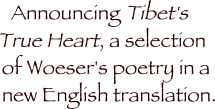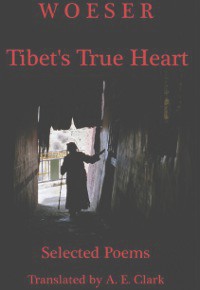The whole town’s full of toxic milk;
Tibetans fond of sweet tea should be careful
Lhasa folks are practically addicted to sweet tea. It would be hard to count the sweet−tea shops that line the highways and byways of Lhasa. I couldn’t say how many Tibetans of all ages gather every day at tony establishments like Dzétrö, Revolution, Gangjong, and Luktsang. There are tea houses next to the temples, too, and prior to March they were packed with Buddhist pilgrims and monks. In every sweet−tea house you’ll see beggars walking to and fro, a hand thrust out for change.
As for the price of sweet tea, in the past a glass cost two mao, but now it’s five mao, and the glasses seem to have gotten smaller even as the price has climbed. There are so many sweet−tea drinkers that the waiters would be overwhelmed if they had to keep up with all the glasses to be poured, so now the practice is to put a thermos on the table. Thermoses come in various sizes: one pound, three pounds, up to eight pounds. Among these, a three−pound thermos of sweet tea used to cost three yuan but has risen to seven yuan.
Perfectionists may choose to make their own sweet tea at home, and that involves pouring fresh milk (ideally, from the dairy cattle on a local farm) into the black tea while it’s steeping over a slow fire. But typically what gets added is milk from the supermarket, Yili or Mengniu for example, and a container of that will cost you a couple yuan more than it would inland. Telunsu is five or six yuan more expensive in Lhasa than in Beijing — and people seem to have gotten used to the differential. One can add powdered milk, too, which comes from the supermarket. When finances are straitened, the milk is going to be powdered milk that someone went to buy at the Tromsikhang wholesale market.
In the sweet−tea houses, it’s always going to be powdered milk from the wholesale market at Tromsikhang. You do not see this kind of powdered milk advertised on TV or in the newspapers. The factories are typically in Shaanxi or Gansu and the price is low. Once when I went to Dzétrö to drink sweet tea, I had a look round the enormous, steaming kitchen and saw a small mountain of empty powdered−milk bags piled up, and these were the bags that had been used in only a few hours, a little more than half a day. It’s staggering how much powdered milk they use in a day.
Recently, every corner of China was shaken to learn that Sanlu powdered milk had made tens of thousands of babies and toddlers sick. Next, it came out that more than twenty kinds of powdered milk were “problem milk.” Even name−brand dairy products like Yili and Mengniu had problems. If you think about the cheap no−name milk which is used every day in huge quantities in the sweet−tea shops of Lhasa, and was produced in small factories or workshops, those powdered milks are bound to be “problem milk” too. In fact, compared with Sanlu, they may be even more terrible. What’s been mixed in may be a carbamide that messes you up even worse than melamine. You don’t see this kind of milk in Beijing, you don’t see it in Chengdu, but in Lhasa it’s everywhere; and so many Lhasa people have kept drinking it as if they couldn’t live without it ... what do you think will be the consequences?
I discussed this with a friend in Lhasa. “I wonder how many people in Lhasa have come down with kidney disease.”
“A great many,” my friend says, “My younger brother got sick with that just this year.”
“Does he go to a sweet−tea house?” I ask.
“Every day,” the friend answers.
“Somebody ought to look into this,” I say, “into how many renal patients there are in Lhasa.”
“Who dares?” my friend says. “The facts may be dreadful.”
In the Tibetan districts sustained by agriculture and pastoralism people don’t have ‘problem milk,’ because the farmers and herdsmen keep their own dairy cows and they don’t drink sweet tea. It’s not likely that problem milk is going to make their kids sick. But in these vast regions devoted to farming and grazing there are plenty of other kinds of fake substandard goods: beverages, crackers, instant noodles, candy, etc. Each time they organize a large−scale program such as a horse−racing fair, it draws swarms of small vendors peddling junk. They rush in to make sales. Often I’ve noticed that not only are their wares unfamiliar, but the stuff has in many cases passed its expiration date. The vast lands of Tibet have thus become a dumping ground for bogus and inferior goods.
It is to be hoped that, across Tibet, the government’s quality inspection department will begin to shoulder its responsibilities and as soon as they see counterfeit or substandard goods reach the market they will take action. It is also to be hoped that young people in Tibetan areas will undertake this mission: to collect substandard goods that pose a health hazard and to document the incidence of disease caused by them. Let them travel to Tibetan settlements and nomad grounds in order to make known the dangers of these goods, warning the Tibetan people that these attractive novelties may well be lethally toxic.
Woeser wrote this article for the Tibetan−language service of Radio Free Asia.
Translator’s Notes
Woeser’s original blog entry includes two photographs she took inside the Dzétrö tea−house. Also of interest is a subsequent RFA article indicating that someone may have heeded her suggestion to "look into" the relevant public−health data for Lhasa.
Three of the tea−houses she mentions have Tibetan names. A native of Lhasa now living in New York kindly explains:
Dzétrö — a circumlocution for “shop” which came into use at the height of the Cultural Revolution, when the word “shop” was stigmatized as bourgeois.
Gangjong — Land of Snow
Luktsang — sheep−pen
Thermoses come in various sizes. One pound, three pounds..." It is strange but true that throughout the PRC, the capacity of thermoses is measured by the number of pounds (the English measure of weight) of water they can hold.
Telunsu The Chinese pronunciation of the Mongolian phrase “Terguun Suu”, which means “top−quality milk.” A trademark.


